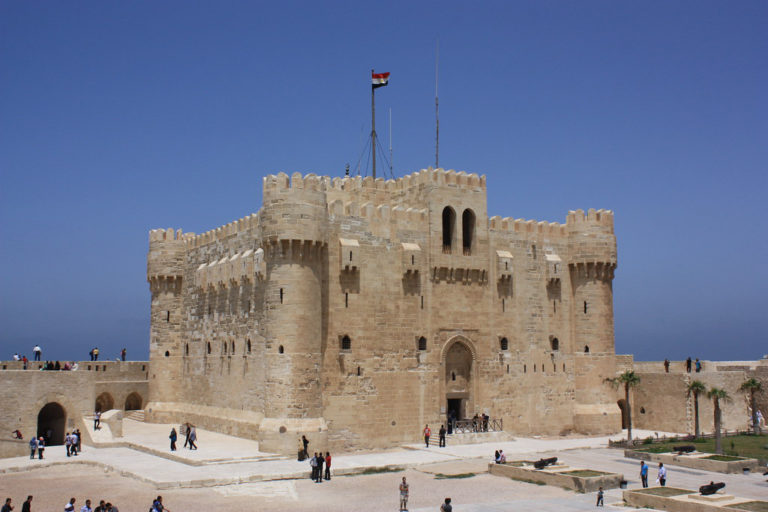Castles do exist outside of Europe. Many of the ones on this list have a clear or strong European history, others not so much. All of them, however, still boast either formidable architectural feats, beautiful and lofty coastal views, or great cultural significance, be they in ruins or still standing.

Photo by Dennis Tsang
1. Citadel of Qaitbay – Alexandria, Egypt
The 15th-century defensive fortress of Qaitbay was established and so named after an Egyptian sultan, and built on the ruins of the Lighthouse of Alexandria, which overlooked the Mediterranean Sea.
The citadel today is a largely intact, and stately structure, patriotically sporting an Egypt flag waving from its battlements.
View this post on Instagram
2. Fasil Ghebbi – Gondar, Ethiopia
Named after the Emperor Fasil or Fasilides, the Fasil Ghebbi citadel was the seat of power in Gondar which he established as the capital of what was then Abyssinia. The 17th-century ruins of Fasil Ghebbi are still magnificent. The architecture comprised of round-shaped stone bastions walls make it quite a unique castle.
View this post on Instagram
3. Fort Jesus – Mombasa, Kenya
Fort Jesus was built in the 16th century by the Portuguese in an attempt to control the sea trade routes. Its design reflects Renaissance architecture, and it was built form coral rock and lime mortar overlooking the ocean at the southern edge of Mombasa, the coastal city overlooking the Indian Ocean.
View this post on Instagram
View this post on Instagram
4. Castle of Good Hope – Cape Town, South Africa
Perhaps the most familiar castle on this list, the Castle of Good Hope in Cape Town is still very much a sought-after tourist attraction. Its history and its use today merges culture and heritage, and is now a space used for various cultural events. Among others, the Castle was built by Khoikhoi slaves and commissioned by the Dutch East India Company in the late 17th century. It’s probably the oldest surviving building in South Africa, and an important, albeit poignant part of our history.
View this post on Instagram
View this post on Instagram
5. Duwisib Castle – Lüderitz, Namibia
This castle in Lüderitz was built by a German soldier, Hansheinrich van Wolf in the early 20th century. Wolf had materials imported from Germany to what was still South West Africa, although the castle’s red sandstone bricks were quarried sourced not too far away. It took about two years to build, with stables and a dressage arena.
View this post on Instagram
6. Fort Santa Cruz – Oran, Algeria
The former Ottoman citadel in the port city of Oran offers some stunning panoramas of the cerulean Mediterranean as well as the Oran coastal landscape. It was rebuilt by the Spanish and restored by the French. It features, from its vantage point, a view of the white dome of the small Santa Cruz chapel, as well as the towering statue of the Virgin Mary at the foot of Mount Aïdour.
View this post on Instagram
View this post on Instagram
View this post on Instagram
7. Elmina Castle – Cape Coast, Ghana
Not too far a drive a from Accra, Elmina Castle can be found along Ghana’s southern shoreline at Cape Coast. The white castle with its formidable, exposed ramparts and large stone central courtyard is still a pretty sight, although it looks a bit rough around the edges now. Construction by the Portuguese started and was completed in the 15th century, but Elmina was later colonised by the Dutch in the mid-17th century. The medieval fortress and its location was a hub of the Trans-Atlantic slave trade.
View this post on Instagram
8. Fort Amsterdam – Kormantin-Abandze, Ghana
Fort Amsterdam was actually built by the British in the 17th century, but was captured by a Dutch admiral during the time of the Dutch East India Company. It’s a pretty sight, and its open-roofed stone ruins sit atop a hill facing the Atlantic Ocean in the Gulf of Guinea.
View this post on Instagram
Featured image: Photo by Dennis Tsang, CC BY-NC-SA 2.0
















